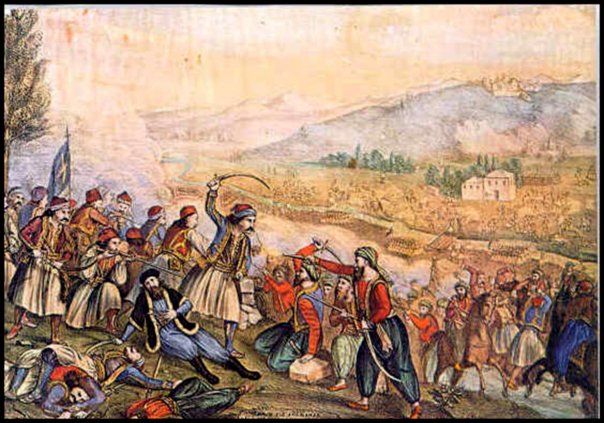
Athanasios Diakos is one of the most famous and tragic figures of the Greek War of Independence.
He spent the early years of his life in theological training at the Monastery of Agios Ioannis Prodromos near Artotina. However, he was forced to flee the serenity of monastic life after an altercation with an Ottoman official and took up arms as a klepht (independence fighter).
Diakos is best known for his courageous last stand at the Battle of Alamana, where he was severely wounded and captured by the Ottomans. The Ottomans offered to spare his life and grant him a position in the Ottoman army on the condition that he go against his own people and renounce his Christian faith. However, Diakos refused and was subjected to torture and death as a result.
Early life of Athanasios Diakos
The man who would later become better known by his pseudonym Athanasios “Diakos”, was born Athanasios Nikolaos Massvetas in the village of Ano Mousounista in Phocis, in 1788, athough some accounts say he was born later in 1791, or that he was from the village of Artotina.
His family lineage was perhaps a clue as to his future activities: his grandfather was also a klepht. Klephts were Greek guerrilla fighters who resisted the Ottomans, mainly in the mountainous and rural areas of Greece.
However, in the early years of his life, Athanasios was drawn more to the Bible than to flintlocks and sabers. He was strongly drawn to his Greek Orthodox faith and was subsequently sent by his parents to the Monastery of Agios Ioannis Prodromos (St John the Baptist) near Artotina to commence theological training.
He became a fully-fledged monk at the age of seventeen and was quickly promoted to take on the role of deacon on account of his strong faith and commendable disposition.
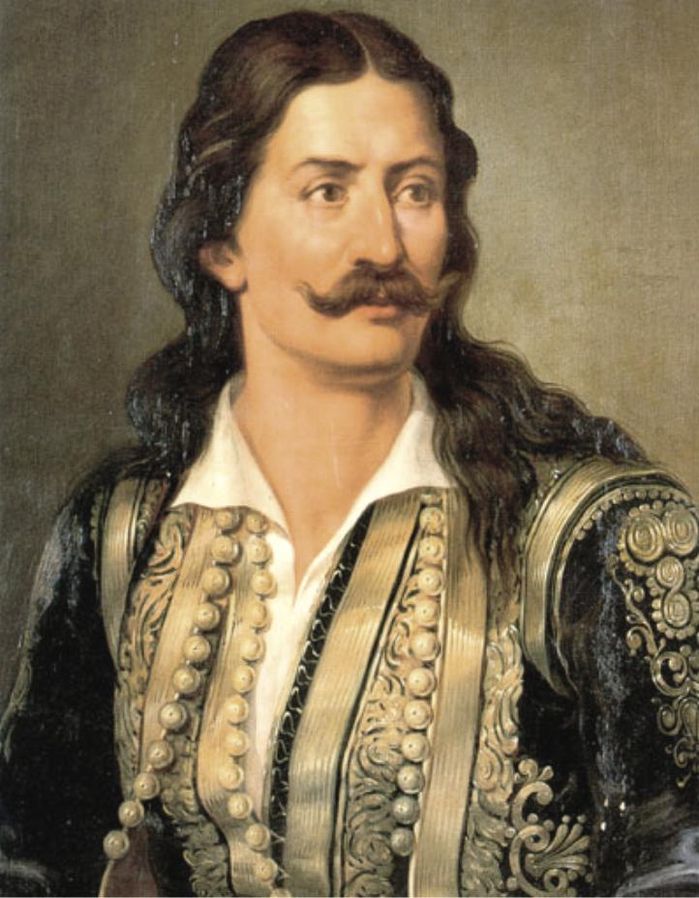
Flight from the monastery
The young Athanasios was not destined for a quiet life, and his time spent at the monastery would come to an abrupt end.
According to the traditional story of his life, an Ottoman pasha and his troops visited the monastery where Athanasios lived. The pasha took a liking to the young clergyman and indecently propositioned him
Athanasios took great offense at the Ottoman pasha’s remarks, and in the ensuing altercation the latter was killed.
Athanasios was forced to flee the monastery for fear of Ottoman reprisals and took refuge in the mountains where he became a klepht like his grandfather before him. In reference to his previous life as a clergyman, he took on the pseudonym “Diakos”, meaning Deacon.
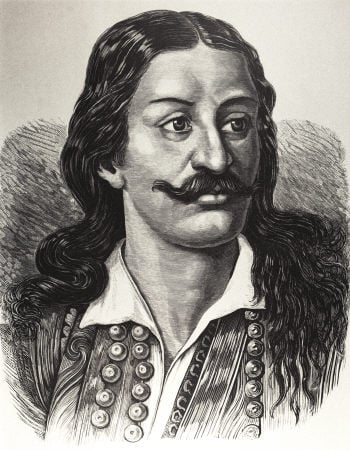
Life as a klepht
Athanasios Diakos, as he then became known, served under the klepht leaders in the region of Roumeli. He bolstered his reputation as a capable warrior in several skirmishes with the Ottomans during this time.
Diakos also served as a mercenary in Ioannina, Epirus, in the army of the infamous Ali Pasha. It was during this time that he befriended the klepht Odysseas Androutsos, who would also go on to become a prominent hero of the Greek War of Independence.
Diakos later served under Androutsos as his second-in-command when the latter was made captain of a band of irregular fighters stationed in the town of Livadeia in Central Greece.
After a stint as Androutsos’ trusted lieutenant, Diakos founded and led his own band of klepthes in the years preceding the outbreak of the revolutionary war. Like many of the klepht leaders, Diakos joined the Filiki Eteria, or “Society of Friends”, founded in 1814 with the purpose of overthrowing Ottoman rule and establishing an independent Greece.

The final stand of Athanasios Diakos at the Battle of Alamana
Soon after the war began in 1821, Diakos and his friend Vasilis Bousgos, who also led a band of fighters, set out to capture the town of Livadeia.
It took three days to liberate the city of Livadeia and involved grueling urban warfare and hand-to-hand fighting in the houses of the town. However, the Greeks prevailed on April 1, and liberated the town, also burning the residence of Mir Aga, the Ottoman official in charge there.
It did not take long for the Ottomans to respond. Hurshid Ahmed Pasha, the Ottoman governor of the Peloponnese, dispatched 8,000 men led by two of his most capable generals, Omer Vrioni and Köse Mehmed, to crush the rebellion.
The Greeks were heavily outnumbered. Even with reinforcements provided by Dimitrios Panourgias and Yiannis Dyovouniotis, Diakos and Bousgos only had about 1,500 men at their disposal to oppose the Ottoman advance. Nevertheless, they decided to take up defensive positions near the legendary site of Thermopylae.
The Greeks split their force in three to defend the most valuable positions. Dyovouniotis positioned his men to defend the bridge at Gorgopotamos, Panourgias took to the heights of Halkomata, and Diakos covered the bridge at Alamana.
The Ottomans also split their force in three to take on the Greeks at each of their defensive positions. The main Turkish contingent attacked Diakos, but he resisted the assault the longest.
Dyovouniotis’ force could not hold the bridge at Gorgopotamos and Panourgias’ men fled when he was wounded. This left Diakos and his men to face the full force of the Ottoman assault alone.
Seeing that the situation was hopeless, Bousgos, who had been fighting alongside his friend, urged him to retreat, but Diakos refused and fought on alongside 48 of his men who also chose to stay.
Diakos and his men put up a valiant struggle for a number of hours, despite being massively outnumbered. The fighting was not confined to musket fire and developed into a close melee struggle. Ultimately, Diakos was severely wounded and captured when his sword broke.
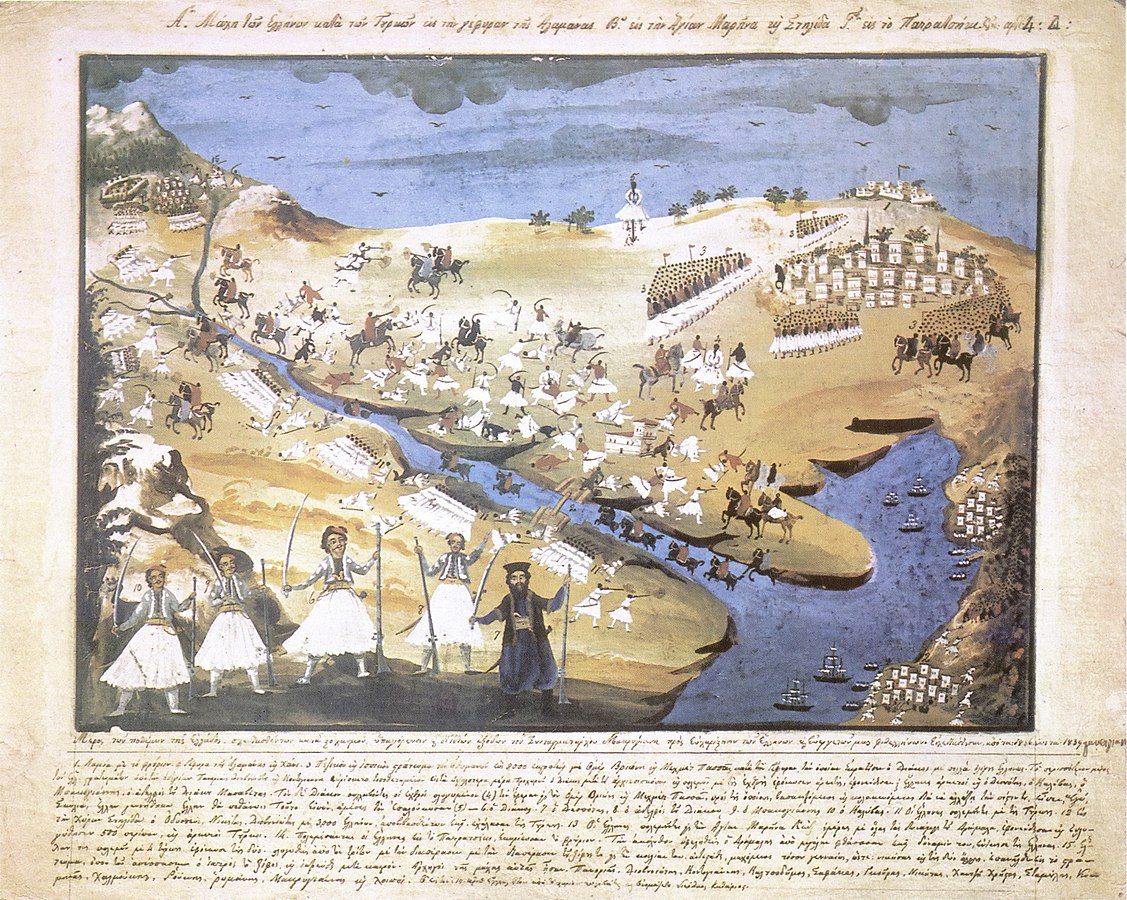
Torture and death
Diakos was brought before one of the Ottoman commanders, Omer Vrioni, who had gained military experience fighting Napoleon in Egypt.
Vrioni made Diakos an offer: his life would be spared if he agreed to take up a post as an officer in the Ottoman army and convert from Christianity to Islam.
Diakos refused to abandon the Greek cause and told Vrioni “I was born a Greek, I shall die a Greek”. He was to be subjected to torture and death as a result.
As he was led off to be executed, Diakos, according to popular tradition, poetically remarked, “Look at the time Charon chose to take me, now that the branches are flowering, and the earth sends forth grass.”
The manner of his death would have been excruciatingly painful. Diakos was impaled on a stake which was driven through the length of his body. Depending on the method, impalement could take days to kill the victim whose every writhing movement on the torture device would have inflicted even more pain.
Initially, the grim death of Diakos served the Ottomans well as a deterrent against future rebellion. However, as time passed, his sacrifice for the Greek cause inspired other revolutionaries to take up the sword and musket to fight for the cause of independence.
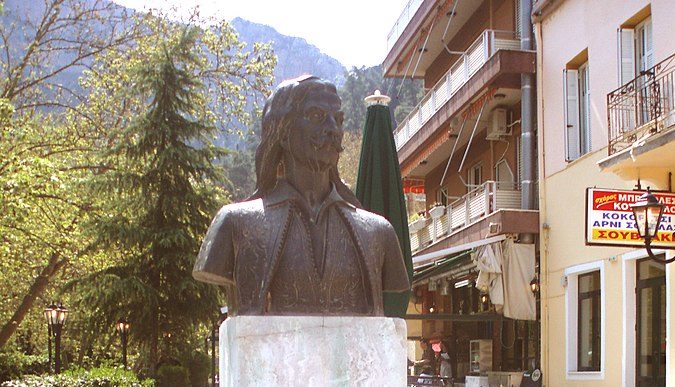
See all the latest news from Greece and the world at Greekreporter.com. Contact our newsroom to report an update or send your story, photos and videos. Follow GR on Google News and subscribe here to our daily email!



